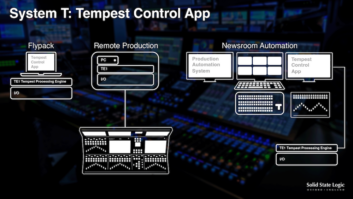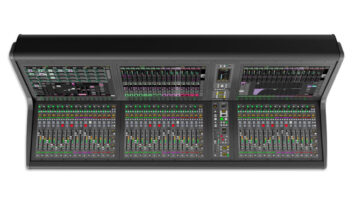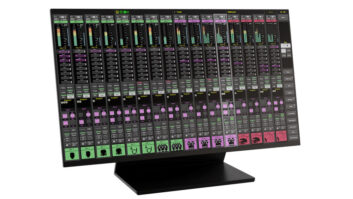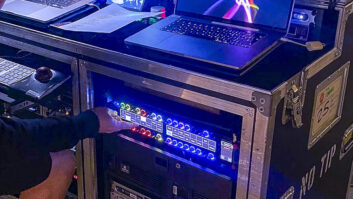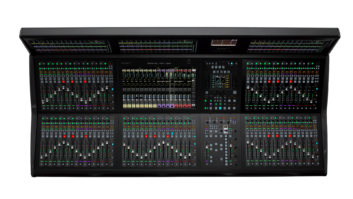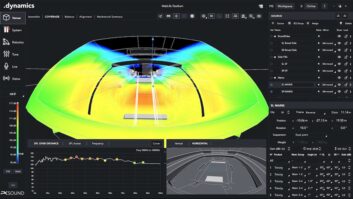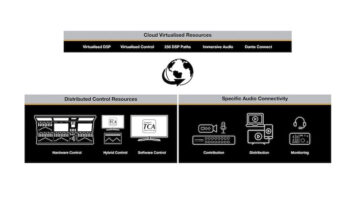The demand for surround sound releases-in sound for picture, multimedia and audio-only forms-is on the rise, yet most of us work on consoles designed specifically for stereo applications. With some clever patching and bus assignments, just about any console can create surround mixes. And an increasing number of new mixers-particularly lower-cost digital boards-incorporate surround panning capability. Unfortunately, while many consoles can create surround mixes, these same boards often cannot adequately monitor in surround. Typically, these mixers are unable to handle such basic functions as simultaneously changing the playback level of all channels, soloing/dimming/muting any output bus, or easily switching between monitor formats (L/R, LCRS, 5.1, etc.).
One solution is Adgil Designs’ The Director, a programmable, microprocessor-controlled system designed specifically for monitor control in multichannel environments. The Director can handle one main monitoring system with up to eight output channels (2, 4, 6 or 8) and two auxiliary stereo systems. Functions include Mute, Dim, Mono and Solo (all available from an external remote control), individual Cut on speakers, preset monitoring levels, variable levels and more.
The Director is based around a central unit called the 9800, a three-rackspace “brain” that contains all the audio and control circuitry. All audio connections are made via DB25 connectors that adhere to standard Tascam DA-88 pinouts, and modular, rear-panel plug-in cards allow for system expansion or customization, providing choices in input routing, matrix routing and bus amps/insert sends. Another card-the communications module-provides interfacing between the brain and the remote control, carrying power and RS-422 control data over a standard DB9 connector, allowing easy fabrication of cables for custom installations. The module also provides GPI capability for specialized functions, such as triggering Record and On-Air lights, or automatically switching an SDU4 into surround or stereo mode when selecting system A, B or C.
Three remote controls are available. The 9822 remote handles LCRS or stereo playback from up to 12 sources, while the top-of-the-line 9840 controller features switching for up to 30 sources, with 7.1 capability. However, the mid-line 9824 remote, with 12-source selection and 5.1 capability, is best suited for most film/music applications.
Once the system is configured, operation of The Director is essentially set-and-forget. A simple interface-consisting of a two-line, 16-character LED screen, data wheel and up/down and left/right cursor keys-allows one to set presets and “program” the 9800 rack. The process is similar to tweaking presets on an SPX90 reverb-it gets the job done, but it ain’t exactly elegant. And as the small screen only displays one parameter/routing at a time, I recommend sketching out your routings on a sheet of paper first and simply entering the new data one step at a time, checking off each change as it’s entered. However, The Director’s programmability offers a lot of flexibility. For example, the mono switch on the remote can be set to route a summed mono to either the center channel speaker only, or to all front speakers simultaneously.
The variable level control is via an endless rotary encoder, which provides 0.375dB-per-step attenuation. This provides a good balance of sensitivity and feel, though going from one volume extreme to another requires turning the knob several times-a volume knob with no stops takes some getting used to. The remote also provides for two playback SPL presets, which can be set to any user-defined SPL, such as 85 dB (film) or 82 dB (for TV work). Another nice touch offered by the remote is a separate volume pot for setting the playback level when the mono switch is active. Additionally, an “insert” switch lets the user insert an encode/decode system (such as Dolby’s SEU4/SDU4 or DP562/DP569) into the chain and instantly make A/B comparisons between discrete and matrixed tracks.
Perhaps the system’s coolest feature is its ability to monitor several sources simultaneously. Simply select several source buttons on the top of the remote and the unit will play all of these tracks simultaneously with their panning/routing intact. In this mode, The Director becomes a fixed 1:1 line-level mixer for stems or submixes. The implementation here is simple, but this feature adds enormous power to the system.
The Director’s audio performance is top notch. Specs include a bandwidth that’s only -0.2 dB at 10 Hz and -3 dB down at 70 kHz, and THD+N is 0.004% (10 to 30k Hz). High-quality DCAs are used for level control throughout the system, and outputs feature relays for power up/down transient protection. All switching is absolutely silent and glitchless in operation, and every switch on the remote has an LED for fast checking of system status.
Adgil’s The Director provides fingertip control for any console requiring flexible surround monitoring. And priced from less than $5,000 to over $10,000 (exact cost depends on system configuration), this is a solution that’s versatile, expandable and priced a lot less than buying a new console.
Adgil Designs, distributed by Sascom, 34 Nelson Street, Oakville, Ont., Canada L6L 3H6; 905/469-8080; fax 905/469-1129. Web site: www.sascom.com.
